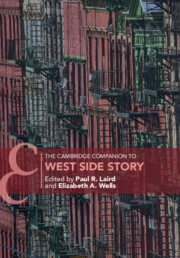Book contents
- The Cambridge Companion to West Side Story
- Cambridge Companions to Music
- The Cambridge Companion to West Side Story
- Copyright page
- Contents
- Figures
- Music Examples
- Contributors
- Preface
- Acknowledgements
- Part I Before West Side Story
- Part II The Work Itself and Its Context
- 7 The Score
- 8 Un-Gendering ‘Somewhere’
- 9 Shakespeare in the City
- 10 West Side Story and the Hispanic Problem
- 11 West Side Story and the Intersections of Class, Colourism, and Racism
- 12 The Real Gang History of New York
- Part III The Legacy
- Select Bibliography
- Index of Songs
- General Index
8 - Un-Gendering ‘Somewhere’
Women’s Agency and Redemption in West Side Story
from Part II - The Work Itself and Its Context
Published online by Cambridge University Press: 09 January 2025
- The Cambridge Companion to West Side Story
- Cambridge Companions to Music
- The Cambridge Companion to West Side Story
- Copyright page
- Contents
- Figures
- Music Examples
- Contributors
- Preface
- Acknowledgements
- Part I Before West Side Story
- Part II The Work Itself and Its Context
- 7 The Score
- 8 Un-Gendering ‘Somewhere’
- 9 Shakespeare in the City
- 10 West Side Story and the Hispanic Problem
- 11 West Side Story and the Intersections of Class, Colourism, and Racism
- 12 The Real Gang History of New York
- Part III The Legacy
- Select Bibliography
- Index of Songs
- General Index
Summary
This chapter offers an intersectional feminist reading of West Side Story that shows how women of color and the gender non-conforming character Anybodys are central to the (partial) redemptive arc of the musical. The narrative and characterizations—as expressed through songs, dances, and score—suggest a path to a better “Somewhere” that requires us to step outside the confines of normative masculinity and femininity which reinforce the boundaries of race and class. Throughout the musical, Anita and Maria must navigate the tensions within the concepts of assimilation and multiculturalism, as well as a social landscape dominated by an anxious and often violent masculinity. Careful attention to performances of these roles, and the character Anybodys, make clear that the belonging they (and we the audience) seek might be found somewhere beyond the reductive and destructive strictures of the gender binary.
- Type
- Chapter
- Information
- The Cambridge Companion to West Side Story , pp. 135 - 153Publisher: Cambridge University PressPrint publication year: 2025

